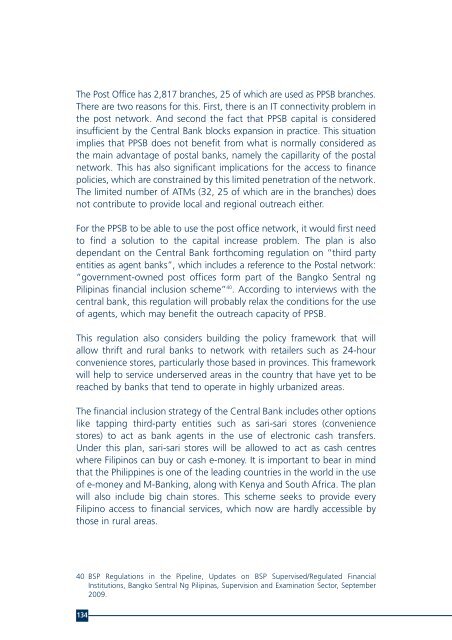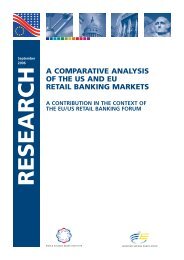Corporate Governance and Access to Finance - ESBG
Corporate Governance and Access to Finance - ESBG
Corporate Governance and Access to Finance - ESBG
You also want an ePaper? Increase the reach of your titles
YUMPU automatically turns print PDFs into web optimized ePapers that Google loves.
The Post Office has 2,817 branches, 25 of which are used as PPSB branches.There are two reasons for this. First, there is an IT connectivity problem inthe post network. And second the fact that PPSB capital is consideredinsufficient by the Central Bank blocks expansion in practice. This situationimplies that PPSB does not benefit from what is normally considered asthe main advantage of postal banks, namely the capillarity of the postalnetwork. This has also significant implications for the access <strong>to</strong> financepolicies, which are constrained by this limited penetration of the network.The limited number of ATMs (32, 25 of which are in the branches) doesnot contribute <strong>to</strong> provide local <strong>and</strong> regional outreach either.For the PPSB <strong>to</strong> be able <strong>to</strong> use the post office network, it would first need<strong>to</strong> find a solution <strong>to</strong> the capital increase problem. The plan is alsodependant on the Central Bank forthcoming regulation on “third partyentities as agent banks”, which includes a reference <strong>to</strong> the Postal network:“government-owned post offices form part of the Bangko Sentral ngPilipinas financial inclusion scheme” 40 . According <strong>to</strong> interviews with thecentral bank, this regulation will probably relax the conditions for the useof agents, which may benefit the outreach capacity of PPSB.This regulation also considers building the policy framework that willallow thrift <strong>and</strong> rural banks <strong>to</strong> network with retailers such as 24-hourconvenience s<strong>to</strong>res, particularly those based in provinces. This frameworkwill help <strong>to</strong> service underserved areas in the country that have yet <strong>to</strong> bereached by banks that tend <strong>to</strong> operate in highly urbanized areas.The financial inclusion strategy of the Central Bank includes other optionslike tapping third-party entities such as sari-sari s<strong>to</strong>res (conveniences<strong>to</strong>res) <strong>to</strong> act as bank agents in the use of electronic cash transfers.Under this plan, sari-sari s<strong>to</strong>res will be allowed <strong>to</strong> act as cash centreswhere Filipinos can buy or cash e-money. It is important <strong>to</strong> bear in mindthat the Philippines is one of the leading countries in the world in the useof e-money <strong>and</strong> M-Banking, along with Kenya <strong>and</strong> South Africa. The planwill also include big chain s<strong>to</strong>res. This scheme seeks <strong>to</strong> provide everyFilipino access <strong>to</strong> financial services, which now are hardly accessible bythose in rural areas.40 BSP Regulations in the Pipeline, Updates on BSP Supervised/Regulated FinancialInstitutions, Bangko Sentral Ng Pilipinas, Supervision <strong>and</strong> Examination Sec<strong>to</strong>r, September2009.134
















